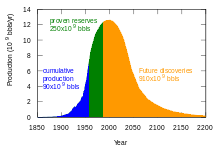Energy descent

Energy descent is the post-peak oil transitional phase, when humankind is predicted to move from the ascending use of energy that has occurred since the industrial revolution to a descending use of energy.
Summary
Energy descent refers to retraction of oil use after the peak oil availability. Planning and preparing for this peak oil energy descent period has been recently promoted by David Holmgren, Rob Hopkins of the Transition Towns movement, and Richard Heinberg in the 2004 book Power down.
That oil reserves are dwindling is now becoming acknowledged more widely, especially after the International Energy Agency released the 2008 World Energy Outlook report.[1] Between 2007 and 2008 the IEA changed its figures for projected rate of decline in world energy supply from 3.7% a year (2007) to a projected rate of decline of 6.7% a year (2008).[2]
In 2008 several major companies including Arup, Yahoo and Virgin created the UK Industry Taskforce on Peak Oil and Energy Security (ITPOES) and released a report, The Oil Crunch,[3] which calls for 'collaborative contingency planning' by government and industry in the face of dwindling oil reserves.[3]
An Energy Descent Action Plan (EDAP) – is a local plan for planning and preparing for energy descent. It goes well beyond issues of energy supply, to look at across-the-board creative adaptations in the realms of health, education, economy and much more. Energy Descent Planning is a process developed by the Transition Towns Movement.
Criticism
Some techno-optimists, such as Julian Simon, have disputed energy projections such as this, arguing that as oil becomes more expensive, humanity will tend to diversify its energy sources away from a reliance on oil, thus avoiding undesired global reductions in energy usage.
See also
- The Carbon War: Global Warming and the End of the Oil Era (book)
- The End of Energy Obesity (book)
- Malthusian catastrophe
External links
- http://www.eatthesuburbs.org/edap-primer/
- De Young, R. (2014). "Some behavioral aspects of energy descent: How a biophysical psychology might help people transition through the lean times ahead." Frontiers in Psychology, 5(1255).